You’re sitting at your favourite restaurant, surrounded by family, when suddenly your hand trembles as you reach for your fork.
The embarrassment washes over you as soup spills across the table. Sound familiar? You’re not alone in this struggle.
Millions of people across the US face daily challenges with grip strength and hand control.
Whether it’s from stroke recovery, arthritis, or simply the natural effects of ageing, adaptive utensils for poor grasp can transform your dining experience from frustrating to fantastic.
But here’s the thing most people don’t realise: the right adapted cutlery for stroke patients and other conditions isn’t just about function, it’s about reclaiming your dignity, independence, and joy in eating.
The question isn’t whether you need help; it’s about finding the perfect tools that work seamlessly with your unique situation.
So, what makes one adaptive utensil better than another, and how do you know which one will change your life?
UNDERSTANDING POOR GRASP AND ITS IMPACT ON DAILY LIFE
Before diving into solutions, let’s understand what we’re dealing with. Poor grasp affects your ability to hold and manipulate objects effectively.
It’s like trying to text with mittens on frustrating and nearly impossible.
What Causes Poor Grasp?
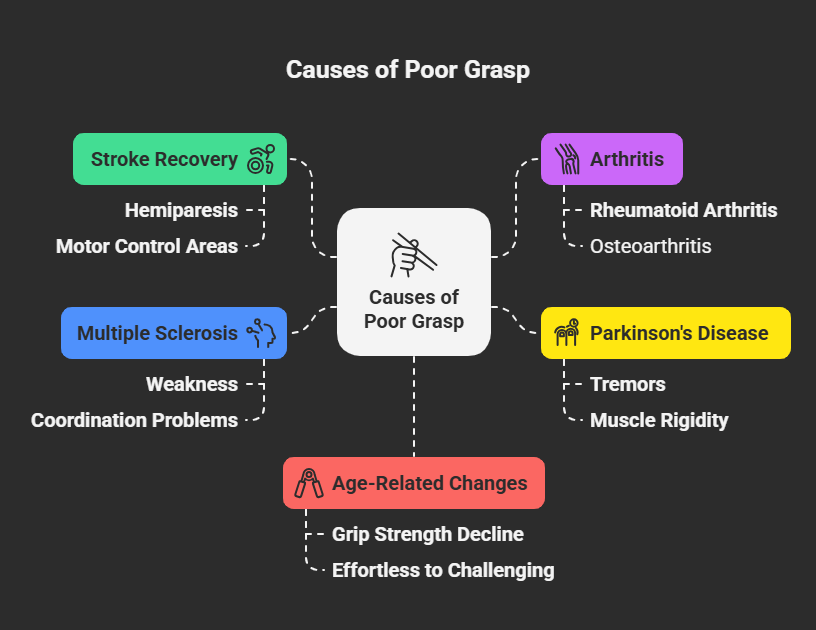
Several conditions can lead to grip difficulties:
Stroke Recovery: When stroke affects your brain’s motor control areas, it can weaken one side of your body. This condition, called hemiparesis, makes simple tasks like cutting food feel like climbing Mount Everest.
Arthritis: Both rheumatoid and osteoarthritis create joint pain and stiffness. Your fingers might feel like rusty hinges that need constant oiling.
Parkinson’s Disease: This neurological condition causes tremors and muscle rigidity. It’s like having your body’s wiring crossed—what you want to do and what actually happens don’t always match.
Multiple Sclerosis: MS affects nerve communication, leading to weakness and coordination problems. Tasks that once felt automatic now require conscious effort.
Age-Related Changes: As we age, our grip strength naturally decreases. What felt effortless at 30 becomes challenging at 70.
The Ripple Effect of Grip Problems
Poor grasp doesn’t just affect eating—it impacts your entire quality of life. Many people experience:
- Social isolation: Avoiding restaurants or family gatherings
- Nutritional deficiencies: Difficulty preparing and eating proper meals
- Loss of independence: Relying on others for basic tasks
- Emotional distress: Feeling frustrated, embarrassed, or depressed
- Safety concerns: Risk of cuts, burns, or choking.
THE SCIENCE BEHIND ADAPTIVE UTENSILS
Understanding how adaptive cutlery for weak grip works helps you make better choices.
These tools aren’t just bigger versions of regular cutlery they’re engineered solutions based on occupational therapy principles.
Key Design Features
Built-up Handles: The optimal diameter for most people is 1.5 to 2 inches. This wider grip reduces the force needed to hold the utensil by up to 60%.
Weight Distribution: Weighted utensils for hand weakness typically weigh 8-12 ounces. The extra weight provides sensory feedback and helps steady trembling hands.
Ergonomic Shapes: Curved and angled designs reduce wrist strain and accommodate limited range of motion.
Non-slip Surfaces: Textured grips prevent the utensil from sliding, even with sweaty or weak hands.
The Biomechanics of Better Eating
According to Dr. Lucas on Wrist & Hand Anatomy, the human hand is made up of 27 bones, about 27 (sometimes cited as 29) joints, and more than 30 muscles working together to provide remarkable dexterity and function.
When this complex system is compromised, adaptive utensils act as force multipliers and stability enhancers.
Think of it like this: if your hand is a car with a faulty engine, adaptive utensils are the turbocharger that gets you back on the road.
TYPES OF ADAPTIVE UTENSILS FOR POOR GRASP: FINDING YOUR PERFECT MATCH
Not all adaptive utensils are created equal. Let’s explore the main categories and their specific benefits.
Built-up Handle Utensils
These are the versatile helpers of adaptive cutlery. Built up handle utensils feature foam or rubber sleeves that increase grip diameter.
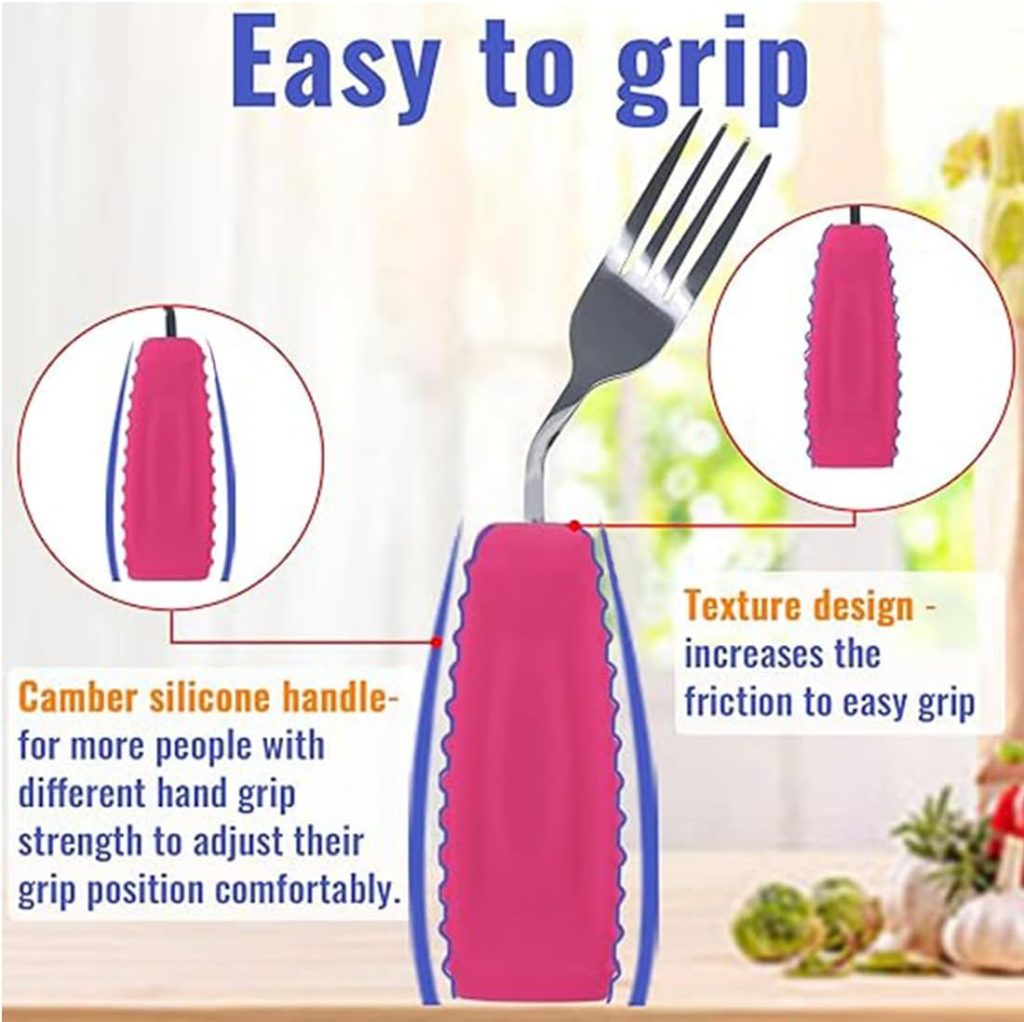
Best for:
- Arthritis sufferers
- Stroke survivors with mild to moderate grip loss
- People with hand tremors
- Those with finger joint deformities
Pros:
- Affordable and accessible
- Easy to clean
- Available in various sizes
- Can be added to existing cutlery
Cons:
- May feel bulky initially
- Not suitable for severe grip loss
- Foam can wear out over time
Weighted and Balanced Utensils
Weighted utensils for stroke patients use physics to your advantage. The extra weight provides stability and reduces the impact of tremors.
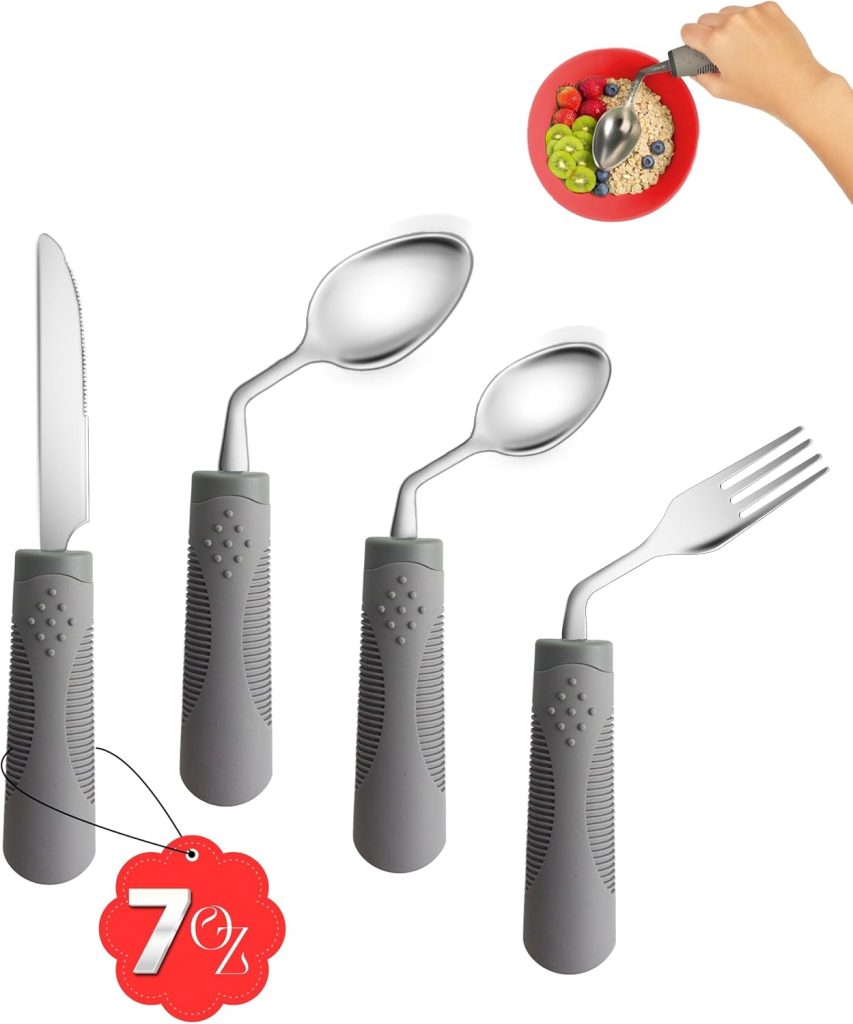
Key Features:
- Weight ranges from 8-12 ounces
- Balanced distribution prevents tipping
- Stainless steel construction for durability
- Ergonomic handles for comfort
Scientific Evidence: Studies show that weighted utensils can reduce hand tremors by up to 45% in people with neurological conditions.
| Feature | Regular Utensils | Weighted Utensils |
| Weight | 1-2 oz | 8-12 oz |
| Tremor Reduction | 0% | Up to 45% |
| Grip Force Required | 100% | 60% |
| Stability | Low | High |
| Cost | $5-15 | $40-80 |
Bendable and Flexible Utensils
These innovative tools adapt to your needs literally. Ergonomic cutlery for disabilities often features bendable stems that can be shaped to accommodate limited range of motion.
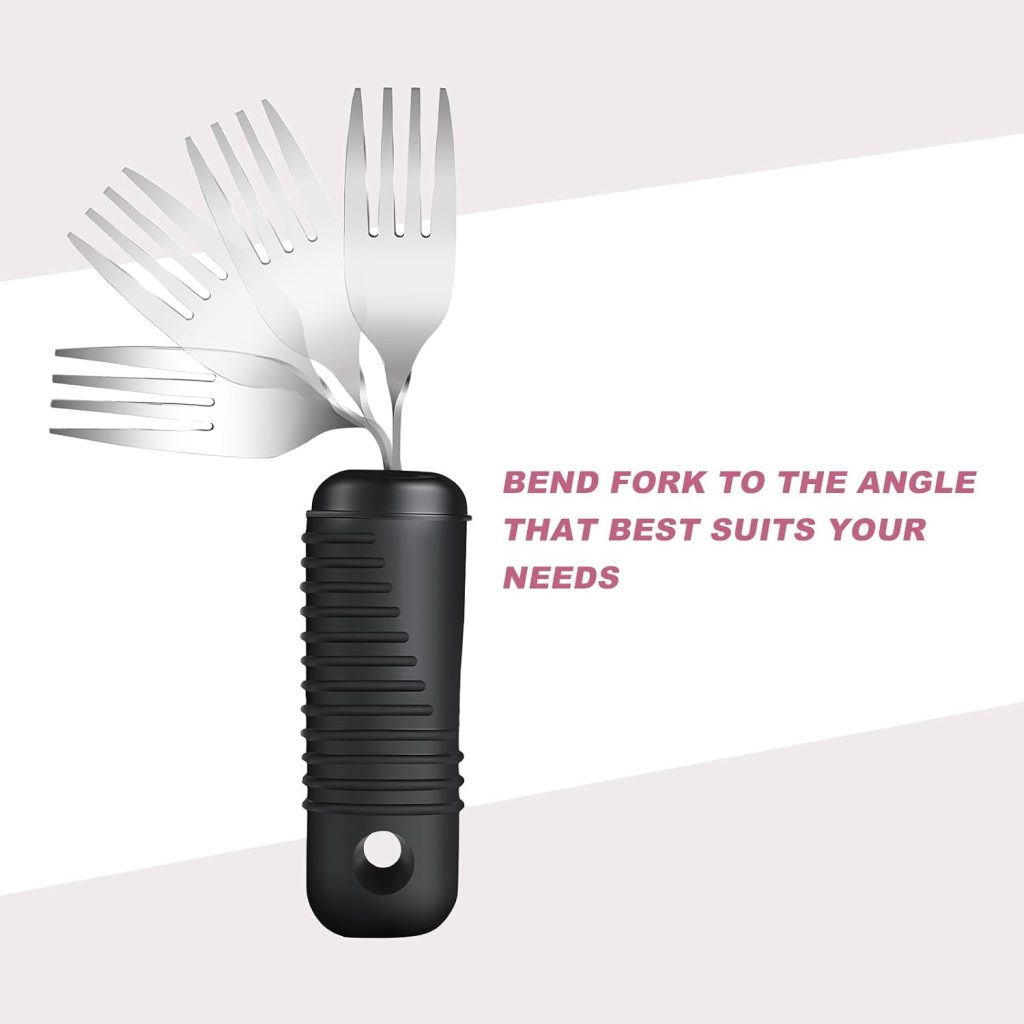
Benefits:
- Customisable angles for each user
- Reduces wrist strain
- Accommodates contractures
- One-time adjustment lasts months
Rocker Knives and One-Handed Solutions
For those with hemiplegia eating utensils needs, rocker knives are game-changers. They cut with a rocking motion instead of a sawing action.
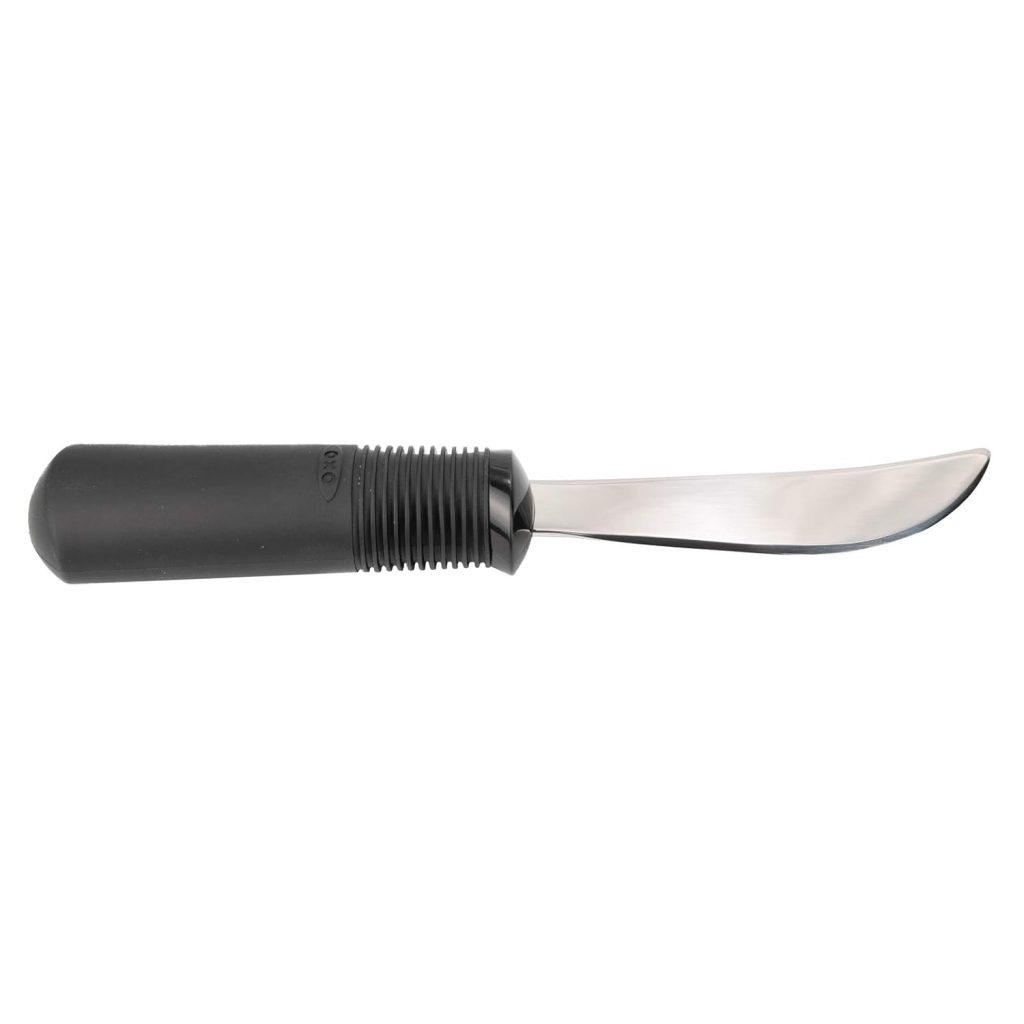
How They Work:
- Curved blade concentrates cutting force
- Single-handed operation
- Reduces fatigue
- Safer than traditional knives
Universal Cuffs and Grip Aids
When your grip is severely compromised, grip aids for utensils provide the missing link between your hand and the tool.
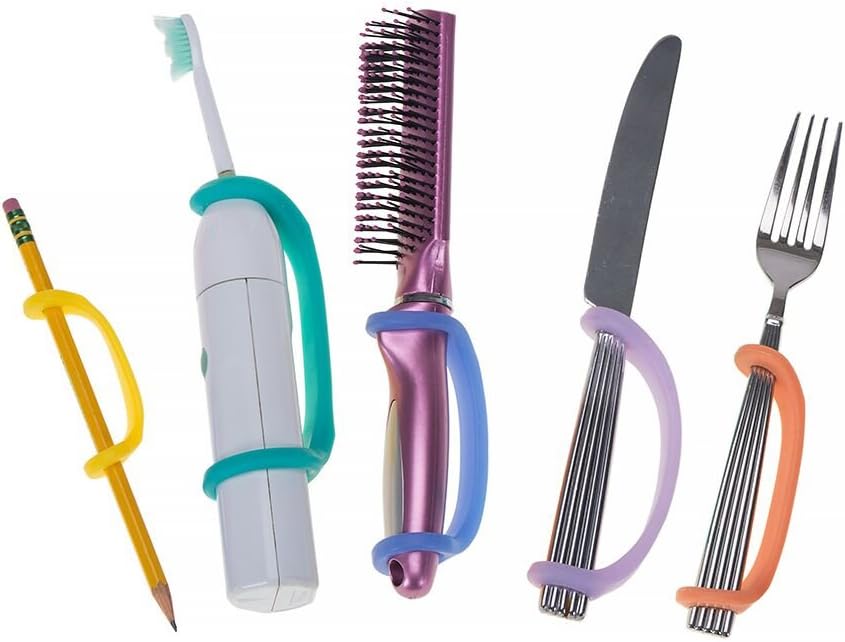
Types Available:
- Velcro strap cuffs
- Rigid plastic holders
- Elastic band systems
- Magnetic attachments.
CHOOSING THE RIGHT ADAPTIVE UTENSILS: A STEP-BY-STEP GUIDE
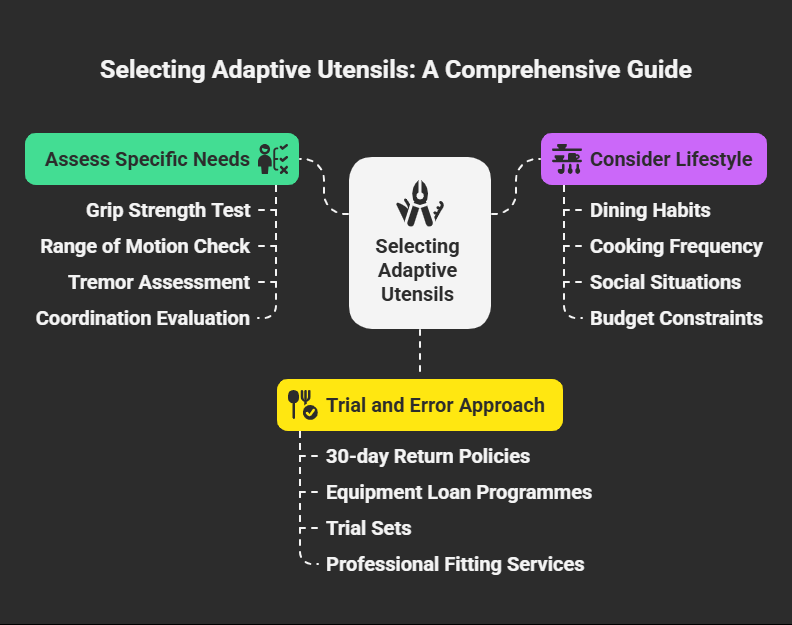
Selecting the best adaptive utensils after stroke or other conditions requires careful consideration. Here’s your roadmap to success.
Step 1: Assess Your Specific Needs
Start by honestly evaluating your challenges:
Grip Strength Test: Can you squeeze a stress ball firmly? If not, you’ll need built-up handles or grip aids.
Range of Motion Check: Can you bend your wrist and move your fingers freely? Limited movement suggests bendable utensils.
Tremor Assessment: Do your hands shake when reaching for objects? Weighted utensils might be your answer.
Coordination Evaluation: Can you coordinate both hands together? One-handed solutions may be necessary.
Step 2: Consider Your Lifestyle
Your daily routine influences the best choice:
Dining Habits: Do you eat out frequently? Portable solutions might be important.
Cooking Frequency: If you cook regularly, consider a complete adaptive kitchen set.
Social Situations: Some people prefer discrete options that don’t draw attention.
Budget Constraints: Adaptive utensils range from £15 to £150 per set.
Step 3: Trial and Error Approach
Most occupational therapists recommend trying before buying. Many suppliers offer:
- 30-day return policies
- Equipment loan programmes
- Trial sets with multiple options
- Professional fitting services.
THE BEST ADAPTIVE UTENSILS FOR SPECIFIC CONDITIONS
Different conditions require tailored solutions. Let’s break down the optimal choices for each scenario.
Stroke Recovery: Eating Utensils for Stroke Patients
Stroke affects everyone differently, but common patterns emerge:
Right-Side Weakness (Left Brain Stroke):
- Weighted utensils for stability
- Built-up handles for better grip
- Rocker knives for one-handed cutting
- Plate guards to prevent spills
Left-Side Weakness (Right Brain Stroke):
- May need additional cognitive support
- Visual cues and reminders
- Simplified utensil designs
- Non-slip place mats
Recommended Products:
- Good Grips Weighted Utensils: Perfect balance of weight and comfort
- Kinsman Bendable Cutlery: Customisable angles for any limitation
- Caring Cutlery Set: Comprehensive solution for stroke survivors
Arthritis: Adaptive Cutlery for Weak Grip
Arthritis creates unique challenges that require specific solutions:
Rheumatoid Arthritis:
- Soft, cushioned grips
- Lightweight options to reduce joint stress
- Ergonomic angles to minimise strain
- Easy-clean surfaces
Osteoarthritis:
- Built-up handles for better grip
- Spring-loaded mechanisms
- Smooth operation tools
- Heat-resistant materials for warm compresses
Top Picks for Arthritis:
- Comfort Grip Utensils: Soft, non-slip handles
- Arthritis Foundation Approved Set: Tested by real users
- Ergonomic Angle Cutlery: Reduces wrist strain significantly
Parkinson’s Disease Solutions
Occupational therapy eating tools for Parkinson’s focus on tremor control:
Essential Features:
- Heavy weight for stability
- Wide, secure grips
- Spill-resistant designs
- Easy-to-clean surfaces
Recommended Options:
- Tremor-Steady Spoons: Electronic stabilisation technology
- Weighted Therapy Utensils: Clinically proven effectiveness
- Parkinsonian Dining Set: Complete solution with accessories
General Weak Hands and Ageing
For overall weakness without specific conditions:
Key Considerations:
- Gradual progression as strength declines
- Multi-purpose functionality
- Cost-effective solutions
- Easy maintenance
Best Choices:
- Progressive Grip Set: Adjustable difficulty levels
- Senior-Friendly Cutlery: Designed specifically for ageing hands
- Everyday Adaptive Tools: Discrete yet effective.
HOW TO IMPROVE GRIP STRENGTH FOR EATING: BEYOND UTENSILS
While adaptive utensils are essential, improving grip strength for eating through exercises and techniques can enhance your independence.
Simple Grip Strengthening Exercises
Squeeze Ball Therapy: Use a stress ball for 5-10 minutes daily. Start with soft resistance and gradually increase.
Finger Extensions: Place a rubber band around your fingers and spread them apart. Hold for 5 seconds, repeat 10 times.
Wrist Circles: Gentle circular motions help maintain flexibility and reduce stiffness.
Putty Exercises: Therapeutic putty provides resistance training for individual fingers.
Occupational Therapy Techniques
Professional occupational therapists can teach:
- Compensatory strategies
- Energy conservation methods
- Adaptive positioning
- Equipment customisation
Timing and Medication Considerations
For those with neurological conditions, meal timing matters:
Parkinson’s Disease: Eat during “on” medication periods when symptoms are better controlled.
Stroke Recovery: Schedule meals when energy levels are highest, typically earlier in the day.
Arthritis: Consider anti-inflammatory medications before meals to reduce joint pain.
STROKE PATIENT INDEPENDENCE DINING: CREATING THE PERFECT ENVIRONMENT
Your dining environment plays a crucial role in successful adaptive utensil use.
Table Setup Optimisation
Height Matters: Tables should be 28-30 inches high for wheelchair users, 30-32 inches for seated dining.
Lighting: Adequate lighting prevents shadows and improves visibility. Aim for 50-100 lux at table level.
Stability: Non-slip placemats and table pads prevent dishes from sliding.
Accessibility: Keep frequently used items within easy reach—typically 18-24 inches from your seated position.
Plate and Bowl Selection
High-Contrast Colours: Dark food shows better on light plates and vice versa.
Raised Edges: Plates with lips or guards prevent food from sliding off.
Weighted Bases: Heavy bowls stay put during use.
Appropriate Sizes: 8-9 inch plates work best for most adaptive utensils.
Creating Independence
Preparation Strategies:
- Pre-cut foods when possible
- Choose appropriate textures
- Arrange foods for easy access
- Have cleanup materials ready
Safety Considerations:
- Remove trip hazards
- Ensure good lighting
- Keep emergency contacts handy
- Consider alert systems for living alone.
COST ANALYSIS: INVESTMENT VS. INDEPENDENCE
Understanding the financial aspects helps you make informed decisions about adaptive utensils.
Price Ranges and Value
Budget Options ($15-30*):
- Basic built-up handle sets
- Foam grips for existing utensils
- Simple plate guards
- Universal cuffs
Mid-Range Solutions ($40-80*):
- Weighted utensil sets
- Bendable cutlery
- Rocker knives
- Complete dining systems
Premium Options ($100-200*):
- Electronic stabilising devices
- Custom-fitted solutions
- Professional-grade equipment
- Comprehensive therapy sets
N:B The prices above are not factual, kindly check with your most preferred retailer.
MAINTENANCE AND CARE: KEEPING YOUR TOOLS IN TOP SHAPE
Proper maintenance ensures your adaptive utensils last longer and remain hygienic.
Daily Cleaning Routines
Immediate Rinsing: Clean utensils immediately after use to prevent food buildup.
Gentle Washing: Use warm, soapy water and avoid abrasive cleaners.
Thorough Drying: Pay special attention to textured grips where moisture can hide.
Sanitising: Weekly disinfection with mild bleach solution (1:10 ratio).
Long-term Care
Grip Replacement: Foam grips typically last 6-12 months with regular use.
Hardware Checks: Inspect moving parts monthly for wear or damage.
Storage: Keep utensils in a dry, clean drawer or container.
Professional Servicing: Annual check-ups for electronic devices.
When to Replace
Signs It’s Time for New Utensils:
- Visible wear on gripping surfaces
- Loose or wobbly parts
- Difficulty cleaning thoroughly
- Changes in your condition requiring different features
- Damage that affects function or safety.
THE FUTURE OF ADAPTIVE UTENSILS: INNOVATION AND TECHNOLOGY
The field of adaptive utensils continues to evolve with exciting developments on the horizon.
Smart Technology Integration
Electronic Stabilisation: Advanced gyroscopic systems that counteract tremors in real-time.
Pressure Sensors: Utensils that adjust their grip assistance based on your current strength.
Bluetooth Connectivity: Tools that track eating patterns and provide health insights.
Voice Activation: Utensils that respond to voice commands for hands-free operation.
Material Advances
Shape-Memory Alloys: Utensils that automatically adjust their shape to your grip.
Antimicrobial Coatings: Surfaces that actively prevent bacterial growth.
Lightweight Composites: Materials that provide strength without excessive weight.
Sensory Feedback Systems: Grips that provide tactile cues for proper positioning.
PROFESSIONAL SUPPORT: WHEN TO SEEK HELP
While this guide provides comprehensive information, professional support remains invaluable.
Occupational Therapy Services
Initial Assessment: Comprehensive evaluation of your specific needs and challenges.
Equipment Trials: Access to various adaptive utensils for testing before purchase.
Training Programs: Proper technique instruction for optimal benefit.
Follow-up Support: Regular check-ins to adjust strategies as needed.
Questions to Ask Your Therapist
- Which specific utensils are best for my condition?
- How long should the adjustment period take?
- Are there exercises to improve my grip strength?
- What warning signs should I watch for?
- How often should I reassess my needs?
LIVING WELL WITH ADAPTIVE UTENSILS: A HOLISTIC APPROACH
Success with adaptive utensils extends beyond the tools themselves—it’s about embracing a new way of living.
Mindset Shifts
From Limitation to Adaptation: View adaptive utensils as tools for empowerment, not symbols of disability.
Progress Over Perfection: Celebrate small improvements rather than comparing to past abilities.
Independence Over Pride: Sometimes accepting help leads to greater long-term independence.
Quality Over Quantity: Focus on enjoying meals rather than eating speed or efficiency.
Building Support Networks
Family Education: Teach loved ones about your tools and how to support you.
Community Groups: Connect with others facing similar challenges.
Online Forums: Share experiences and learn from others worldwide.
Professional Networks: Maintain relationships with healthcare providers.
Staying Motivated
Set Realistic Goals: Celebrate achievements like eating an entire meal independently.
Track Progress: Keep a journal of improvements and challenges.
Reward Success: Treat yourself when you master new techniques.
Stay Positive: Remember that adaptation is a process, not a destination.
FREQUENTLY ASKED QUESTIONS
Most people need 1-2 weeks to feel comfortable with new adaptive utensils.
The adjustment period varies based on your specific condition and the type of utensils you’re using. Start with shorter meals and gradually increase usage time.
Absolutely! Many people carry portable adaptive utensils when dining out. Most restaurants are accommodating when you explain your needs.
Some adaptive utensils are designed to look similar to regular cutlery for discretion.
While weighted utensils help many people, they’re not suitable for everyone.
Those with severe weakness, certain heart conditions, or specific neurological conditions should consult healthcare providers before using weighted utensils.
Consider occupational therapy if you’re experiencing difficulty with daily activities, have recently been diagnosed with a condition affecting your hands, or are struggling despite using adaptive equipment. Your GP can provide referrals.
CONCLUSION: YOUR PATH TO DINING INDEPENDENCE
The journey with adaptive utensils isn’t just about eating it’s about reclaiming your independence, dignity, and joy in life’s simple pleasures.
Whether you’re recovering from a stroke, managing arthritis, or dealing with age-related changes, the right tools can transform your dining experience.
Remember these key takeaways:
Start Early: Don’t wait until difficulties become overwhelming. Early adoption leads to better outcomes.
Seek Professional Guidance: Occupational therapists provide invaluable expertise in selecting and using adaptive utensils.
Be Patient: Allow time for adjustment and celebrate small victories along the way.
Stay Connected: Maintain social dining experiences, they’re crucial for mental health and quality of life.
Embrace Innovation: New technologies and designs continue to improve adaptive utensil options.
The right adaptive utensils aren’t just tools they’re keys to independence, confidence, and continued enjoyment of life’s shared moments around the table.
Are you ready to take the next step towards dining independence? Contact your local occupational therapy service or explore adaptive utensil options today.
Resources and Further Reading:
- National Stroke Association USA – Comprehensive stroke recovery resources
- Arthritis Foundation – Support for arthritis sufferers
- Parkinson’s UK – Information on Parkinson’s disease management
- College of Occupational Therapists – Find qualified occupational therapists.
This article is for informational purposes only and should not replace professional medical advice. Always consult with healthcare providers before making significant changes to your eating habits or equipment.